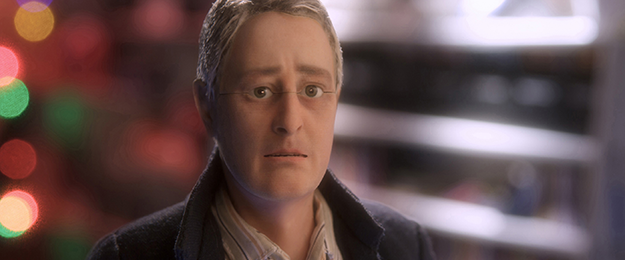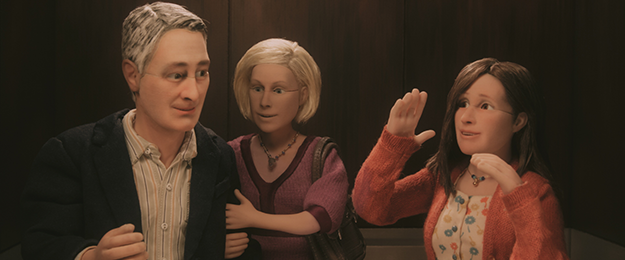Film of the Week: Anomalisa

Discussions of CGI have of late inherited a term that was first in use, I think, in the fields of robotics and then of computer games. The term is the “uncanny valley” and it refers to a certain point in the development of realistic artificial simulacra of human beings. A robot, or a photorealistic CGI image of a human, may be developed to such a degree of resemblance to a real person that a certain point is reached at which the resemblance becomes too close, and therefore too unsettling, to be anything other than disturbing. It’s the conjunction of resemblance and irreducible difference that upsets us, that makes us recoil from a somehow unacceptable relation to the genuinely human.
I’m not sure that this phenomenon altogether accounts for what’s unsettling about Anomalisa, a film which, in any case, doesn’t feature CGI-created humans. But there’s something genuinely uncanny about the puppets in this extraordinary feature co-directed by Charlie Kaufman and animator Duke Johnson, a film that manages at once to be moving, horribly funny and deeply disturbing. It’s a film in which the uncanny valley is revealed not as a negative but rather as a kind of sweet spot at which the humanity within unhuman things is revealed to incredibly poignant and philosophically rich effect. There’s a whole body of writing and whole fields of art that attempt to account for dolls’ capacity to appear as alternative repositories of the soul, and generally to make us worry about the nature of our own human identity (E.T.A. Hoffmann, Freud, Hans Bellmer et al), and I won’t go over these fundamentals here; suffice to say that Anomalisa induces a subtle panic from the word go, and that panic only deepens.
The partly Kickstarter-funded film is Kaufman’s long-awaited directing follow-up to his big Human Condition statement of 2008, Synecdoche, New York. He’s made it in collaboration with animator Duke Johnson, best known for TV titles including Moral Orel and Mary Shelley’s Frankenhole. Anomalisa, which first started life as a stage piece that starred the same three-person cast, presents us with a very mundane situation. Michael Stone (voiced by David Thewlis), a middle-aged English resident of Los Angeles and a consumer services guru, arrives in Cincinnati to address a conference. He takes a taxi where the driver hard-sells the virtues of the local zoo, and insists he try the local chili. Then he checks into a bland corporate hotel, the Fregoli*, where the porter insists on droning on about the nice weather they’re having lately. He nervously calls the ex-girlfriend he abandoned years earlier; they meet, but it’s a disaster. Later a fit of panic sends him knocking at another door in the corridor, where he meets two young women, Emily and Lisa, who agree to have a drink with him. He sleeps with Lisa, who’s shy and who makes a big impression on him—because she’s different.

She’s literally different, because she’s voiced by Jennifer Jason Leigh. Everyone else in the film—including the hotel staff, the taxi driver, his ex, and Emily—speaks with exactly the same bland droning monotone, provided by Tom Noonan. They all have the same interchangeably blank face too—the only two characters who seem capable of expression are Michael and Lisa. And she has a distinctive individuality—a virginal coy innocence, and idiosyncratic character traits. She likes pressing buttons, she plays the Jew’s harp (“I don’t like to say Jew’s harp because it’s offensive to Jews”), and her favorite song is Cyndi Lauper’s “Girls Just Wanna Have Fun,” which she sings first in English, slowly, then again in Italian, as in the version by Sarah Brightman (is there such a version? We’ll take Kaufman’s word for it). It’s a song she can relate to: “’I wanna be the one who walks in the sun.’ That describes so perfectly who I want to be.”
You could feel that the gaucheness, if not downright idiocy, of sweet-natured Lisa is presented with a kind of lofty contempt—except that the film manages to persuade us that much older, more worldly Michael isn’t entirely foolish in falling for her starry-eyed twitterings so completely. And those twitterings are voiced perfectly by Leigh with a little-girl lilt that becomes all the more perfectly musical, in an abstract sense, the more thoroughly banal her discourse becomes. Michael, meanwhile, carries in his very voice the weight of experience and disappointment—the dour grain of his Northern English accent suggests a man who’s gone to L.A. and found hollow success of a kind that he can only resent and regret.
The film is an essay in mundanity, and for the first half-hour, I was wondering exactly how these events, this affectless dialogue, would have come across in a live-action film: like a tired remake of Up in the Air, I imagine. Later in the film, things do become downright surreal in a way that’s instantly recognizable as Kaufman-esque—I won’t spoil the shift of tone for you, but it does involve, first, a curious Japanese automaton, and later, a hair-raising encounter with the hotel staff. But the action could have remained in absolutely everyday mode and still been deeply strange, just by virtue of its being acted out by puppets. The settings—the hotel rooms, bar, lift, taxi, and so on—are realistic in a neatly reduced dollhouse fashion. But the people occupy a borderline behind puppethood and quasi-humanity. Their faces were created by 3-D printing, their skins have a strange fabric-like fibrousness, and the eyes are somehow, for reasons I couldn’t quite fathom, a lot more expressive and biological-seeming than the glass eyes usually used on humanoid dolls in animation (it turns out that these eyes were custom-made, similarly 3-D–printed, and painted with a special glaze).

These figures are human and not human, puppets that are illusionistic and yet that proclaim their fakeness. Above all, they have replaceable faces: each figure has a very visible seam across its forehead and round its jawline. This is standard in such puppets: it’s common practice for them to have interchangeable faces to maximize the possibilities of facial expression. But it’s the normal custom to hide these seams, digitally or however; Kaufman and Johnson, however, draw our attention to them. These are puppets that tell us they are puppets. They are playing human beings that don’t realize that they are actually puppets. And at certain points they seem to be puppets that know they are puppets. The film keeps all these different dimensions hovering in place, the oscillation between them generating an existential unease that’s quite momentous.
Anomalisa‘s contemplation of love, desire, delusion, and plain bitter depression are, I suppose, timeless, but the film is also particularly of its moment in what it has to say about the dehumanizing effects of consumer-service culture: “Look for what is special in each individual” is a horrifying phrase when used in the context of a lecture on increasing productivity. The film’s attack on managerial cant, and the way that it makes puppets of us all, is especially sobering in the wake of the recent New York Times report on Amazon and its work culture. But Anomalisa is partly a commentary on language and automatism in the tradition of Ionesco’s The Bald Soprano—it’s not specifically a satire on the way we live now. Yes, Kaufman is asking questions, and painful ones: as Michael muses at one point, “What is it to be human? What is it to ache? What is it to be alive?” But, as he also says: “Sometimes there’s no lesson. That’s a lesson in itself.” The tenderness and chilling mystery of Anomalisa are their own lessons, or non-lessons.
* Named after a condition called the Fregoli delusion.







